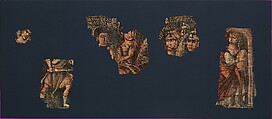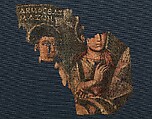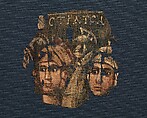Restituted in August 2022 This work of art has been removed from the Museum's permanent collection. Learn more about The Met's collecting practices.
Exodus Painting, five elements from a painted hanging depicting the Crossing of the Red Sea
Not on view
These five evocative paintings most compellingly evoke the moment when the traditional painting styles and themes of the Late Antique, Greco-Roman world expand to include Judeo-Christian themes. The realistically evoked bodies and expressive faces suggest Roman narratives that survive only in contemporary descriptions and on sarcophagi that have long lost their richly painted surfaces. The works were probably originally used in a burial in Egypt, where the images, as part of a large hanging, would have been an outermost layer of the burial wrappings. The surviving painted elements are from a depiction of the Crossing of the Red Sea as described in Exodus, especially verses 14:19 – 15:20. From the left, the figures are the head of the Angel of the Lord going behind the Israelites; a torso of an Israelite soldier; the Philistines astonished at the Israelite success; the army of the Pharaoh; and Mariam celebrating the successful crossing by playing on her tymbrel. The Philistines and soldiers are identified by inscriptions in Greek as “the astonished people” and “the army.” The works were made when Egypt was a sophisticated part of the Roman Empire ruled from Rome or New Rome, Constantinople. A fragmentary large hanging in the Abegg Foundation depicting events in Exodus is carbon 14 dated to A.D. 129-346, probably the timeframe of the “Exodus Paintings.” Those dates place the “Exodus Paintings” well before the depiction of the Crossing of the Red Sea beside the Torah niche on the walls of the Dura-Europus synagogue in Syria (first destroyed ca. A.D. 256). Or, if made at the later end of the date range, the paintings might have been made for Christian use, as the event became considered a symbol of universal baptism and salvation by the fourth century. Sarcophagi with similar depictions of Mariam appear ca. A.D. 380. Further study will help determine if these examples of the epic treatment of biblical history were part of the developing visual voice of the Jewish or Christian tradition, decorating a church or synagogue, or the aristocratic home of a devout member of either faith.
This image cannot be enlarged, viewed at full screen, or downloaded.
This artwork is meant to be viewed from right to left. Scroll left to view more.


























